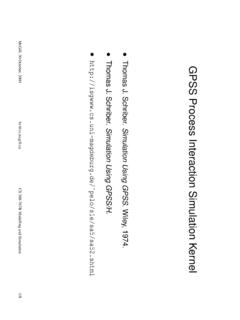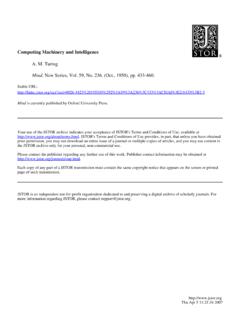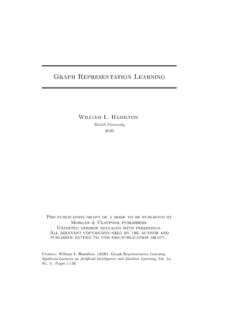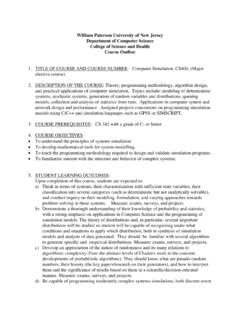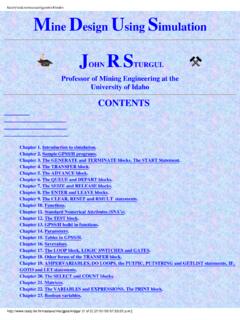Transcription of Perspectives on simulation using GPSS - cs.mcgill.ca
1 Proceedings of the 1988 Winter simulation Conference M. Abrams, P. Haigh, and J. Comfort (eds.) Perspectives on simulation using GPSS Thomas I. Schriber Graduate School of Business Administration The University of Michigan AM Arbor Ml 48109-1234 USA ABSTRACT A broad overview of the simulation modeling language GPSS is given. The class of problems to which GPSS applies especially well is described, and commentary on the semantics and syntax of the language is offered. Various GPSS implementations are indicated, and vendor information is given. The GPSS learning-oriented literature is reviewed, and sources comparing GPSS and other simulation languages are cited.
2 Professional GPSS courses are listed. A GPSS model and its output are presented and discussed in an appendix. The GPSS tutorial at the 1988 Winter simulation Conference will show how one goes about building GPSS models. Paper copies of the tutorial transparencies will be given out at the tutorial. 1. GPSS IN BRIEF GPSS (General Purpose simulation System) is a popular (Christy and Watson, 1983) simulation modeling language whose use greatly eases the task of building computer models for certain types of discrete-event simulations. (A discrete-event simulation is one in which the state of the system being simulated changes at only a discrete, but possibly random, set of time points, called event times.)
3 GPSS lends itself especially well to modeling systems in which discrete units of traffic compete for scarce resources ( , queuing systems), and is useful in determining how well such sys- tems will respond to the demands placed on them. GPSS has been applied, for example, to the modeling of manufacturing systems, communication systems, computing systems, transportation systems, inventory systems, and health-care systems, and has been used in chemical engineering, mining engineering, and cancer research. 2. THE SEMANTICS AND SYNTAX OF GPSS GPSS offers a rich set of semantics, and yet is sparse in its syn- tax.
4 For example, only seven statements (plus several run-control statements) are required to model a one-line, one-server queuing system in GPSS. These statements take such simple forms as GENERATE l&6 and QUEUE LINE . No read, write, format, or test statements appear in the model. And yet, when a simulation is performed with the model, fixed-form, fixed-content output is pro- duced, providing statistics for the server ( , number of times cap- tured; average holding time per capture; fraction of time in use) and the waiting line ( , average content; maximum content; average time in line), etc. This limited example is roughly suggestive of the character of GPSS.
5 A GPSS model for the one-line, one-server system is given here in an appendix. The sparse syntax of GPSS, coupled with its block-diagram orientation, makes it possible for the beginner to learn quickly a usable subset of the language. Because GPSS is rich and versatile, however, considerable study is required to master the language. The GPSS world view (stylized way of looking at a problem) involves visualizing units of traffic ( transactions ) which move along paths in a model as a simulation proceeds. This world view is so natural to the modeling of queuing systems that many other simulation languages have adopted it.
6 The effect of this cross- fertilization can be found in such languages as SIMAN (Pegden 1982), SIMSCRIPT (Russell 1983), SIMULA (Birtwistle 1979), and SLAM (Pritsker 1986). 3. VARIOUS GPSS IMPLEMENTATIONS GPSS is a multi-vendor language. (75s is in contrast with such languages as SIMAN, SIMULA, SLAM, and SIMSCRIPT.) First released by International Business Machines (IBM) in 1961, GPSS evolved through a series of IBM releases (GPSS II; GPSS III; C~ sS/360; and, in 1970, GPSS V (IBM 1970)), each an enhance- ment of its predecessor. Paralleling the IBM releases, a number of GPSS implementations were done for IBM and non-IBM hardware by non-IBM vendors.
7 (See GPSS VENDOR INFORMATION below.) Wolverine Software s GPSSIH, which is an upwardly compatible superset of IBM s GPSS V, is the state-of-the-art GPSS for IBM mainframes and compatible computers ( , the Amdahl 470 series, the Amdahl 5860, and National Advanced Systems NAS-9000) (Henriksen et al. 1988). Written in assembly language, mainframe GPSS/H (Release 1, 1977; Release 2, 1988) also runs on the IBM PClATl370. GPSS/H can be used on VAX computers as well, including the MicroVAX I, MicroVAX II, and MicroVAX 2000 ( desktop VAX ); and the 11/7xx and 8xxx machines. It also runs on Apollo; on Inte- grated Solutions Optimum 500 and Optimum V; on the NCR Tower32; on Silicon Graphics IRIS and IRIS Turbo; and on Sun Microsystems Sun-3.
8 These non-mainframe implementations are written in C . An MS/DOS C implementation of GPSS/H which will run models of moderate size is also available. GPSS/H models can be transported across all GPSSH implementations (subject to possible size constraints if downloading to MS/IX% GPSSRI). MINUTEMAN Software vends GPSS/PC, which is a popular implementation of GPSS for the IBM PC. GPSS/PC was released in Version 1 in 1984 and in Version 2 in 1986 (Cox 1986, 1987). Version 3 is expected in 1989. Another GPSS implementation for the IBM PC is simulation Software Ltd. s GPSSR/PC (Richards 1981, 1983). simulation Software Ltd.
9 Also offers two other GPSS implementations: GPSSNX, for VAXNMS systems and MicroVAX systems (Martin 71 1981); and GPSS/C, for such 32-bit architecture colmputer systems as VAX UNIX, ELXSI UNIX, SUN-3 UNIX, PYRAMID UNIX:, NCR Tower UNIX, Data General MV/ECLIPSE, and the HP9000 Series 500 (Richards 1984). Comments on the GPSS-FORTRAN (Schmidt 1987) offered try a German company, Dr. Staedtler Gmbh, are given below under LANGLJAGES WITH GPSS EMBEDDED. No one keeps a comprehensive list of current GPSS imple- mentations. In general, people not in a position to use IBM s GPSS V, MINUTEMAN s GPSS/PC, a simulation Software Ltd.
10 GPSS implementation, Staedtler s GPSS-FORTRAN, or Wolverine s GPSS/H, must do their own spadework to determine if a supported GPSS implementation is available for their computer system. 4. GPSS, GRAPHICS, AND ANIMATION MINUTEMAN Software s GPSS/PC, Version 2, provides built-in graphic and simulation animation features, including showing transaction movement in block diagrams; animation of movement of objects in two-dimensional representations of the system being mtxl- eled; and dynamic display of statistical aspects of a model, , his- tograms portraying the ongoing realization of a random variable s relative frequency function; and plots of the time series of values being taken on by variables of interest (Cox, 1987).

